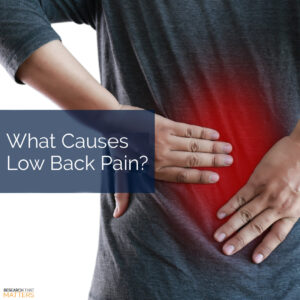section-02280fe
Top Healthcare Organizations Recommend This for Low Back Pain
 Bottom Line:
Bottom Line:
According to The Lancet, low back pain is the number one source of disability in the world. If you’ve dealt with low back pain in the past, you understand just how much it can alter your daily life. Even simply standing up straight can feel like an incredibly impossible task, and for that reason, many top healthcare organizations have begun to publish recommendations for the best ways to take care of low back pain.
Their findings may surprise you.
Why it Matters:
The care provided by chiropractors ranks at the top of many leading healthcare recommendations for relieving low back pain. Movement-based strategies like spinal adjustments, controlled exercise, and dynamic stretching are a few of the most effective ways to relieve low back issues. Not only are movement-based strategies good for providing fast relief, but emerging research shows that they may be able to offer a preventative effect when continued over time.
The days of taking drugs and medications for back pain are over. Prescriptions are now rarely recommended as a first option because of their dangerous side effects and, frankly, lack of results.
- The American College of Physicians supports chiropractic care for the treatment of back pain.
- Both Harvard Health and The Mayo Clinic have published numerous articles highlighting chiropractic and movement-based treatment options for low back pain relief.
- Clinical care guidelines discourage the use of medication for low back pain due to the risks, dangers, and lack of results.
Next Steps:
We’re happy that major, trusted healthcare organizations have evolved to support natural ways to find relief from low back pain. If you or someone you know is struggling with back pain, reach out to us today. Our practice will provide you with a thorough evaluation to determine the source of your problem and the best unique care plan designed specifically to help you find relief.
Science Source(s):
section-3845968
Science Says the Best Way to Treat Sciatica is…
 Bottom Line:
Bottom Line:
If you’ve ever fallen to your knees in pain because of sciatica, you know how scary it can be. Pain that locks up your low back and travels down your leg after sneezing, coughing, or bending over is one of the least welcomed surprises you can experience in your life.
Sciatic pain is caused when a spinal disc, excess bone, or overgrown ligaments begin to pinch the nerves in your low back that travel down your buttocks and legs all the way to your feet. Do you know the best way to find relief?
Why it Matters:
You may be surprised to learn that disc bulges and herniations are quite common as we get older, and a majority of the time, they don’t cause any pain.
That’s right. You can and may have various spinal disc issues that aren’t causing you any pain. However, if a nerve in your low back is pinched, your body is sure to let you know about it with a jolt of pain.
It may seem like the only way to “take care” of a bulged or herniated disc is by cutting it out with surgery, but that’s not the case. The best way to treat sciatica is with the care offered in our practice. Stretching, exercise, and spinal adjustments have all been shown to be extremely effective at reducing the pain associated with sciatica because they reduce the pinching (or compression) on your spinal nerves.
- Controlled movement of your spinal joints can help reduce the inflammation and pain.
- Surgery is a last resort, and it’s estimated that less than 5% of people with sciatica are good candidates for surgical intervention.
- A recent study found that people with lumbar disc herniations had more relief (over 60%) with spinal adjustments than with spinal injections.
Next Steps:
Having sciatica doesn’t mean that you are destined for surgery. In fact, the majority of people with disc issues and sciatica can get well using chiropractic care. Remember, your spine is resilient, your spinal discs can heal, and that we’re here to help!
Science Source(s):
section-8702f34
What Causes Low Back Pain?
 Bottom Line:
Bottom Line:
Low back pain is something that over 80% of us will deal with at some point in our lives… but what exactly causes low back pain? Usually, it’s not just one thing that causes low back pain, but there are some trends and information that we’ve uncovered about the primary causes, and most importantly, what you can do to avoid it.
Why it Matters:
Your low back is made up of 5 bones with spinal discs in between them. These bones act as protection for your spinal cord as it travels down and out the left and right sides between each segment. Supporting this incredible structure is a variety of ligaments, tendons, and muscles.
Most low back pain occurs because the stress on a particular area of your spine has outweighed your body’s ability to adapt. If the stress on an area is too much, then an injury may occur. The most common low back injuries are sprain and strains and spinal disc bulges or herniations.
In most cases, these injuries can heal pretty quickly with the right care.
- Abnormal motion of the spinal joints in your low back can cause pain.
- A double-blind, randomized, controlled trial found spinal adjustments to be superior to both placebo and NSAID’s in the care of low back pain.
- Periodic chiropractic visits may prevent future episodes of low back pain.
Next Steps:
The best way to reduce your risk of low back pain is by being proactive with your health. Daily movement, dynamic stretching, regular exercise, and spinal adjustments are all important steps you can take to keep your low back in tip-top shape. If you have questions about how you can implement these proactive steps in your daily routine to help reduce your chance of experiencing low back pain, reach out to us today!
Science Source(s):
Spinal High-Velocity Low Amplitude Manipulation in Acute Nonspecific Low Back Pain. Spine. 2013.
section-1bd1ad9
The Surprising Science About Surgery for Low Back Pain
 Bottom Line:
Bottom Line:
Many people think that surgery can “fix” an area of their spine that is injured. While in rare cases that’s true, the permanent changes that surgery makes to your anatomy can cause a host of new problems in addition to the trauma and risks that inherently go along with surgery.
The changes are referred to as “adjacent segment disease,” and they are the number one reason why people who have one surgery on their low back often have to repeat the process.
Why it Matters:
A recent study found that chiropractic care can provide the same relief as surgery for disc issues in the low back, and that’s without any of the surgical risks.
The kicker is those individuals who didn’t get great results with chiropractic care were found to be great surgical candidates. So, in most cases, it’s clear that anyone entertaining the idea of surgery should go to the chiropractor before going under the knife!
- An estimated 60% of patients with sciatica benefited from spinal adjustments to the same degree as if they had received surgery.
- Over 25% of patients undergoing spine surgery may have complications.
- Patients with disc herniations should consider chiropractic care before surgical intervention.
Next Steps:
Having surgery is a big, irreversible decision. The time away from work, risks associated with anesthesia, the direct trauma to your spine, and results that aren’t exactly fantastic have all led many doctors to question whether surgery is a good option (outside of emergency cases).
In our practice, our goal is to help you avoid unnecessary addictive drugs and risky medical procedures so that you can find health and healing naturally. And if you are one of the rare people who may benefit from surgery, we’ll let you know. Our team is dedicated to providing you with the best care recommendations based on your goals and our findings. It’s how we believe healthcare should be delivered.
Science Source(s):
Manipulation or Microdiskectomy for Sciatica? A Prospective Randomized Clinical Study. JMPT. 2010.
Risk of Complications in Spine Surgery. Open Orthopaedics Journal. 2









